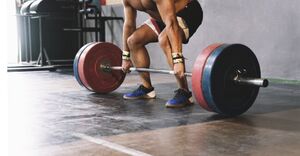
5 Essential Tips for Finding the Right Kettlebell Size for Your Fitness Goals
Looking to add a new dimension to your workout routine? Kettlebells might just be the perfect addition for you.
We will explore what kettlebells are, the benefits of using them, how to choose the right size for beginners, common mistakes to avoid, recommended sizes, and tips on progressing in weight.
Whether you’re looking for a full-body workout, improved strength and endurance, or better cardiovascular health, kettlebells could be the perfect fit for you. Let’s dive in and find your perfect match!
What Is a Kettlebell?
A kettlebell is a versatile and effective fitness tool that resembles a cannonball with a handle attached to it. This compact piece of workout equipment is commonly used for strength and conditioning exercises.
It is designed with a round shape that provides a unique and dynamic way to perform various movements, such as swings, presses, squats, and snatches. Historically, kettlebells were originally used in Russia as counterweights for measuring grain and other goods, eventually evolving into strength training tools.
Today, popular kettlebell brands like Rogue Fitness, CAP Barbell, and Kettlebell Kings offer options made from durable materials like cast iron, steel, or vinyl coating, catering to different preferences in weight and grip. The benefits of incorporating kettlebells into a workout routine include improved grip strength, enhanced cardiovascular fitness, increased power, and muscle endurance, making them an essential tool for fitness enthusiasts looking to achieve overall strength and conditioning goals.
What Are the Benefits of Using Kettlebells?
Using kettlebells offers a multitude of benefits for individuals seeking to enhance their strength, conditioning, and overall fitness levels. These compact weights are excellent tools for full-body workouts.
Incorporating kettlebells into your fitness routine can significantly improve your strength, as they engage multiple muscle groups simultaneously, leading to a more efficient and effective workout experience. By performing exercises such as kettlebell swings, goblet squats, and Turkish get-ups, you can target various muscle groups like the glutes, hamstrings, core, and shoulders.
The dynamic nature of kettlebell movements also helps enhance cardiovascular health by elevating your heart rate and improving endurance over time. The versatility of kettlebells allows for endless workout variations that can keep your routine challenging and engaging.
Full-Body Workout
One of the primary benefits of kettlebell training is its ability to provide a comprehensive full-body workout. By engaging multiple muscle groups simultaneously, kettlebell exercises promote overall conditioning and strength development.
This efficiency makes kettlebells a popular choice for those looking to maximize their time in the gym. Exercises like swings target the glutes, hamstrings, and core, while cleans and snatches work the upper body and improve explosiveness. Squats with kettlebells engage the quads and glutes, while the overhead press strengthens the shoulders and arms. Incorporating deadlifts into your routine helps to build lower back and hamstring strength, completing the well-rounded benefits of kettlebell training for whole-body fitness.
Improves Strength and Endurance
Regular kettlebell workouts can significantly enhance both strength and endurance levels. These exercises not only build muscle but also improve cardiovascular conditioning, making them ideal for beginners and advanced fitness enthusiasts alike.
Kettlebell training engages multiple muscle groups simultaneously, offering a full-body workout in a relatively short amount of time. Beginners can start with basic movements like the kettlebell swing, goblet squat, and Turkish get-up, which are not only effective but also easy to learn and execute. As beginners progress, they can gradually incorporate more complex exercises like the kettlebell clean and press or snatches to further challenge their strength and endurance levels. The versatility of kettlebells allows for endless variations in workouts, ensuring that boredom is kept at bay while consistently improving overall conditioning.
Enhances Cardiovascular Health
Incorporating kettlebell swings into your fitness routine can have a positive impact on cardiovascular health. This dynamic exercise not only strengthens muscles but also enhances heart and lung function, contributing to improved overall conditioning.
The high-intensity nature of kettlebell swings pushes your heart rate up, making it an effective cardiovascular workout. By engaging multiple muscle groups simultaneously, these exercises improve your cardiovascular endurance over time. The combination of strength training and aerobic exercise in kettlebell swings results in a comprehensive cardiovascular workout that helps increase your body’s ability to efficiently transport oxygen and nutrients. This not only benefits your heart health but also boosts your overall stamina and energy levels.
Versatile and Efficient
Kettlebells are renowned for their versatility and efficiency in delivering effective workouts. From strength training to cardiovascular conditioning, these compact weights offer a holistic approach to fitness that is both time-efficient and results-driven.
Incorporating kettlebell exercises into your routine can help improve your muscular endurance, core strength, and flexibility all at once. The dynamic movements involved in kettlebell workouts engage multiple muscle groups simultaneously, making it a superb choice for individuals looking to maximize their time in the gym.
Whether you are aiming to tone your body, boost your metabolism, or enhance your athletic performance, kettlebells provide a comprehensive solution to meet various fitness goals.
How to Choose the Right Kettlebell Size for Beginners?
Selecting the perfect kettlebell size is crucial for beginners embarking on their fitness journey with this versatile tool. Choosing the right starting weight sets the foundation for a safe and effective workout routine.
To determine the ideal kettlebell size, beginners should consider their current fitness level and overall strength. It’s recommended to start with a lighter weight to focus on mastering proper form and technique before progressing to heavier weights. Beginners aiming for endurance and cardio benefits may opt for a lighter kettlebell, while those focusing on strength may choose a slightly heavier option. Remember to seek guidance from a certified trainer or instructor to ensure proper usage and prevent injuries during kettlebell workouts.
Determine Your Fitness Level
Before choosing a kettlebell size, beginners should assess their current fitness level to ensure they select a weight that aligns with their strength and conditioning capabilities. This initial step helps in setting realistic starting points for effective workouts.
As individuals embark on their fitness journey with kettlebells, it’s crucial to understand that selecting the right weight goes beyond just picking up any kettlebell. By evaluating your current physical abilities through exercises like bodyweight squats, push-ups, and planks, you can gauge your strength and endurance levels.
This self-assessment allows you to identify areas of improvement and tailor your kettlebell weight selection accordingly. Remember, choosing a weight that is too heavy can lead to improper form and potential injury, while a weight that is too light may not provide the desired challenge for muscle growth and overall progress.
Consider Your Goals
When determining the right kettlebell size, beginners should consider their fitness goals and what they aim to achieve through kettlebell workouts. Tailoring weight selection to match specific objectives enhances the effectiveness of each exercise session.
- For individuals focusing on building strength and muscle mass, selecting a heavier kettlebell can provide the resistance needed to stimulate muscle growth.
- On the other hand, those aiming for improved endurance and cardiovascular fitness might benefit from using a lighter kettlebell for higher repetitions.
- Individuals aiming for a balance of strength and endurance should opt for a moderate weight that allows them to perform a variety of exercises without compromising form or intensity.
Start with a Lighter Weight
As a beginner, it is advisable to start with a lighter kettlebell weight to focus on mastering proper technique and form. Beginning with a weight that allows for correct execution of exercises sets the stage for progression and skill development.
By prioritizing form and technique over heavy lifting at the onset of your kettlebell journey, you can establish a solid foundation that will serve as a crucial building block for future success. Ensuring that each movement is performed with precision not only reduces the risk of injury but also enhances the effectiveness of your workouts. Gradually increasing the weight as your strength and proficiency improve will not only prevent plateaus but also promote continuous growth and improvement in your kettlebell training.
Get Proper Instruction
To ensure a successful start in kettlebell training, beginners should seek proper instruction from qualified fitness professionals or trainers. Learning the correct technique and form under guidance minimizes the risk of injury and maximizes workout efficiency.
This guidance is crucial as kettlebell workouts involve dynamic movements that require precise execution to prevent strain or mishaps. Trained instructors can provide personalized feedback on posture, breathing techniques, and progression strategies.
When looking for reliable guidance, consider seeking certified kettlebell trainers at reputable fitness centers or online platforms endorsed by fitness organizations. Exploring instructional videos, books, or workshops from recognized kettlebell experts can enhance your understanding and practice for a safer and more effective workout experience.”
What Are the Common Mistakes to Avoid When Choosing a Kettlebell Size?
When selecting a kettlebell size, beginners often make certain mistakes that can hinder their progress and lead to potential injuries. Avoiding these common errors is essential to ensuring a safe and effective workout experience.
One mistake new users often make is choosing a kettlebell that is either too light or too heavy. Opting for a weight that is too light may not provide enough resistance to see significant improvements, while a kettlebell that is too heavy can strain muscles and lead to improper form. Beginners may overlook the importance of proper technique, such as maintaining a strong core, using the legs to generate power, and avoiding swinging the kettlebell solely with the arms. It’s crucial to focus on form to prevent injuries and maximize the effectiveness of the workout.
Choosing a Weight That Is Too Heavy
One of the primary mistakes beginners make is opting for a kettlebell that is too heavy for their current strength and skill level. This error can lead to improper form and technique, increasing the risk of strain or injury during workouts.
Starting with a manageable weight allows beginners to focus on mastering proper kettlebell techniques, such as the swing or clean. Overwhelming the body with a weight that is too heavy can compromise form, leading to muscle imbalances and potential joint issues. It’s essential to listen to the body and gradually progress to heavier kettlebells as strength and proficiency improve.
By building a strong foundation with lighter weights first, beginners can prevent setbacks and ensure a safe and effective kettlebell training journey.
Not Considering Your Strength and Endurance
Neglecting to account for individual strength and endurance levels is a common mistake when choosing a kettlebell size. Matching the weight to one’s capabilities is crucial for executing exercises safely and effectively without compromising form.
To assess personal fitness levels accurately, individuals can start by testing their strength and stamina with bodyweight exercises like squats, push-ups, and planks. Understanding one’s baseline fitness helps in determining an appropriate starting kettlebell weight.
It’s essential to remember that starting with a lighter kettlebell and gradually increasing the weight is a prudent approach. Progression should be gradual to avoid injuries and ensure that strength and endurance develop steadily over time.
Ignoring Proper Form and Technique
Overlooking the importance of proper form and technique is a critical mistake beginners should avoid when using kettlebells. Focusing on mastering correct execution ensures optimal muscle engagement and reduces the risk of injuries.
By prioritizing form and technique, individuals can enhance the effectiveness of their kettlebell workouts while also safeguarding themselves from potential strains and sprains.
Paying attention to posture, alignment, and movement patterns is key to reaping the full benefits of each exercise. Remember to maintain a neutral spine, engage the core muscles, and avoid excessive swinging or jerky movements.
Consistency in practicing proper form not only yields better results but also establishes a strong foundation for progress and growth in strength and fitness levels.
What Are the Recommended Kettlebell Sizes for Beginners?
For beginners, selecting the right kettlebell size is crucial for a successful workout experience. Recommended weight ranges tailored for men and women provide a starting point for individuals looking to incorporate kettlebell training into their fitness routines.
It’s commonly suggested that women begin with kettlebell weights ranging from 8kg to 12kg to build strength and technique effectively, while men typically start with weights ranging from 12kg to 16kg. It is essential for beginners to focus on proper form and avoid selecting weights that may compromise their technique.
Gradual progression is key to preventing injury and ensuring continued improvement in strength and endurance. By starting with manageable weights and gradually increasing as strength improves, individuals can tailor their training to their specific capabilities and fitness goals.
Men: 8-16 kg (18-35 lbs)
Men who are starting their kettlebell journey are advised to begin with weights ranging from 8 to 16 kg (18 to 35 lbs). These recommended sizes cater to novice individuals looking to build strength and enhance their overall fitness levels.
Starting with lighter kettlebells helps men in mastering proper form and technique before moving on to heavier loads. This gradual progression reduces the risk of injuries and allows muscles to adapt efficiently.
By gradually increasing the weight as strength improves, men can continuously challenge their bodies and see significant gains in muscle mass and endurance. Selecting the right kettlebell size that aligns with one’s current fitness level is crucial for skill development and long-term progress in kettlebell training.
Women: 4-12 kg (9-26 lbs)
For women embarking on kettlebell workouts, recommended sizes typically range from 4 to 12 kg (9 to 26 lbs). These weights provide a suitable starting point for beginners to develop strength, coordination, and endurance through kettlebell training.
Starting with lighter kettlebells allows one to focus on mastering proper form and technique before gradually increasing the weight. This progressive approach not only reduces the risk of injury but also ensures a solid foundation for future advancements in strength and skill. Consistent practice with lighter kettlebells aids in muscle memory development and overall physical conditioning, paving the way for improved performance and mastery of more challenging movements in the long run.
How to Progress in Kettlebell Weight?
Advancing in kettlebell weight requires a strategic approach that prioritizes gradual progression and technique refinement. As beginners gain strength and confidence, increasing the weight incrementally while focusing on proper form enhances workout effectiveness.
It is crucial for beginners to start with a weight that they can handle comfortably to prevent injury and build a solid foundation. By regularly assessing their readiness for heavier weights through self-awareness and monitoring physical cues, individuals can gauge their progress accurately. Once a certain weight becomes manageable, they can consider moving up to the next level to continue challenging themselves. Consistent practice and patience are key in mastering kettlebell techniques, as this not only aids in injury prevention but also ensures optimal performance and results.
Gradually Increase Weight
To progress effectively in kettlebell training, beginners should adopt a gradual approach to increasing weight loads. Incrementally adding resistance allows for steady skill development and strength gains without compromising form or risking injury.
This approach not only builds a strong foundation but also helps prevent overexertion which can lead to burnout or setbacks. Beginners should focus on mastering proper technique with lighter weights before progressing to heavier loads. It is essential to pay attention to how the body responds to different weights and adjust accordingly. Tracking progress through a training journal can aid in evaluating performance and determining when it’s time to level up. Remember, patience and consistency are key to long-term success in kettlebell training.
Listen to Your Body
Listening to one’s body signals is essential when progressing in kettlebell weight. Beginners should pay attention to fatigue, discomfort, and performance indicators to gauge their readiness for advancing to heavier weights or adjusting training intensity.
Body awareness plays a crucial role in preventing injuries and ensuring continual improvement. Being attuned to how your body responds to each kettlebell exercise is key to refining your form and technique.
Progress should not only be measured by weight increments but also by improved movement quality and increased endurance. Listen to subtle cues such as better range of motion, reduced fatigue during workouts, and enhanced stability as signs of progress and readiness to challenge yourself further in your kettlebell training journey.
Focus on Form and Technique
Maintaining a strong focus on form and technique is paramount for successful weight progression in kettlebell training. Prioritizing proper execution of exercises ensures muscle engagement, injury prevention, and long-term skill development.
As individuals advance in weight loads, refining their technique becomes increasingly crucial. Attention to detail in movements such as the kettlebell swing, clean, and snatch can significantly impact workout efficacy and safety. Common errors like rounding the back or using too much momentum must be addressed to avoid strain and maximize results. By honing in on key points like hip hinge mechanics, grip strength, and breath control, athletes can enhance their performance and unlock the full potential of their kettlebell training regimen.
External Resource :https://nutroone.com/en/product-category/weight-train/kettlebell/




No Comments